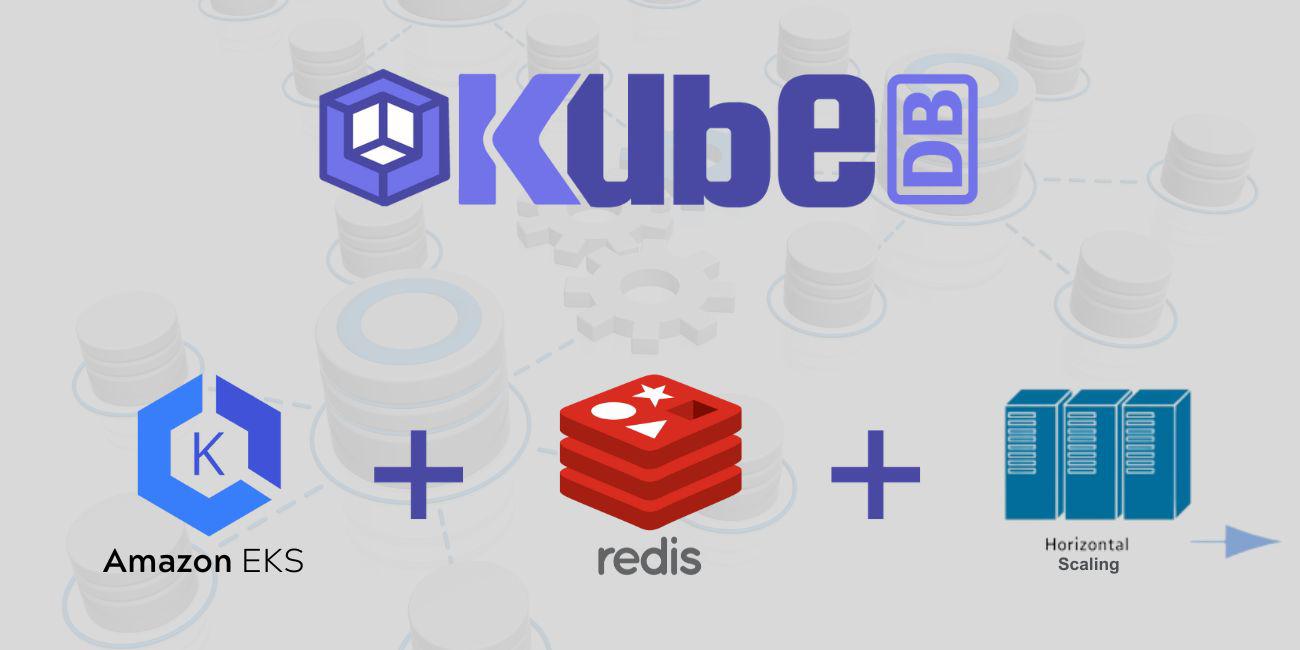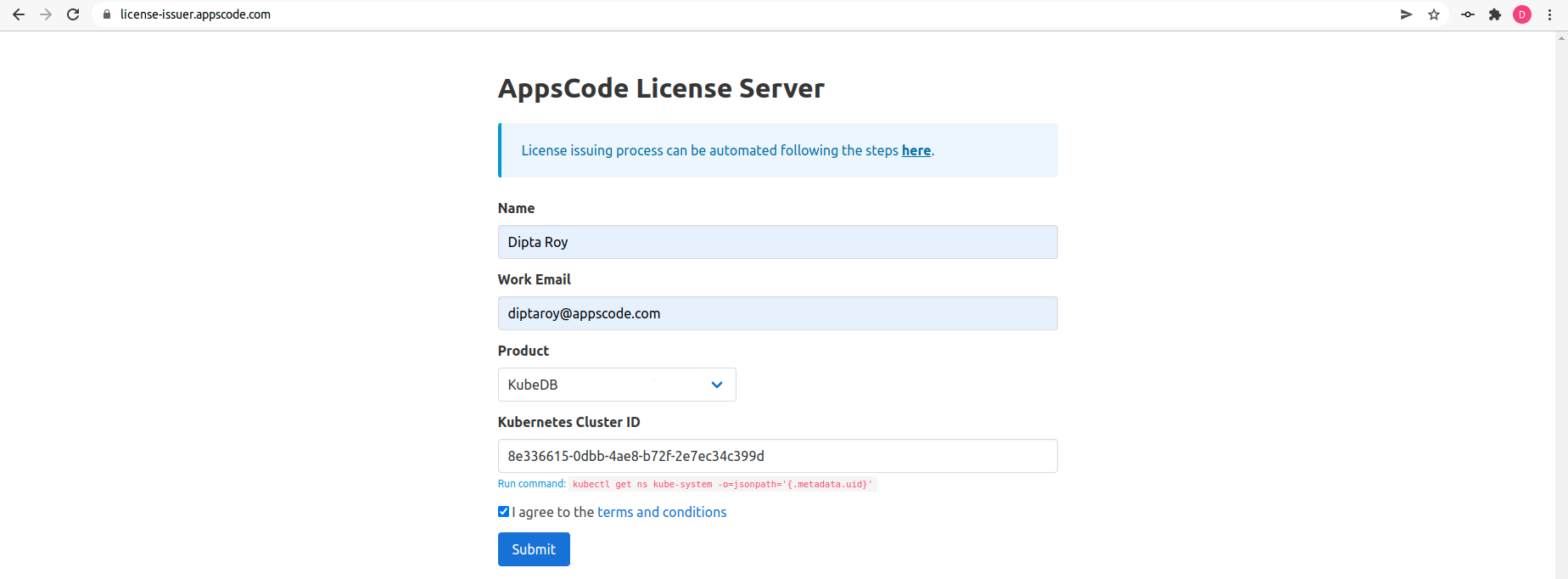
Overview
KubeDB is the Kubernetes Native Database Management Solution which simplifies and automates routine database tasks such as Provisioning, Monitoring, Upgrading, Patching, Scaling, Volume Expansion, Backup, Recovery, Failure detection, and Repair for various popular databases on private and public clouds. The databases supported by KubeDB include MongoDB, Elasticsearch, MySQL, MariaDB, Redis, PostgreSQL, Percona XtraDB, and Memcached. Additionally, KubeDB also supports ProxySQL, PgBouncer, and the streaming platform Kafka. You can find the guides to all the supported databases in KubeDB . In this tutorial we will show the horizontal scaling of Redis cluster in Amazon Elastic Kubernetes Service (Amazon EKS). We will cover the following steps:
- Install KubeDB
- Deploy Redis Cluster
- Read/Write Sample Data
- Horizontal Scaling of Redis Cluster
Get Cluster ID
We need the cluster ID to get the KubeDB License. To get cluster ID we can run the following command:
$ kubectl get ns kube-system -o jsonpath='{.metadata.uid}'
8e336615-0dbb-4ae8-b72f-2e7ec34c399d
Get License
Go to Appscode License Server to get the license.txt file. For this tutorial, we will use KubeDB.

Install KubeDB
We will use helm to install KubeDB. Please install helm here
if it is not already installed.
Now, let’s install KubeDB.
$ helm search repo appscode/kubedb
NAME CHART VERSION APP VERSION DESCRIPTION
appscode/kubedb v2023.12.28 v2023.12.28 KubeDB by AppsCode - Production ready databases...
appscode/kubedb-autoscaler v0.25.0 v0.25.0 KubeDB Autoscaler by AppsCode - Autoscale KubeD...
appscode/kubedb-catalog v2023.12.28 v2023.12.28 KubeDB Catalog by AppsCode - Catalog for databa...
appscode/kubedb-community v0.24.2 v0.24.2 KubeDB Community by AppsCode - Community featur...
appscode/kubedb-crds v2023.12.28 v2023.12.28 KubeDB Custom Resource Definitions
appscode/kubedb-dashboard v0.16.0 v0.16.0 KubeDB Dashboard by AppsCode
appscode/kubedb-enterprise v0.11.2 v0.11.2 KubeDB Enterprise by AppsCode - Enterprise feat...
appscode/kubedb-grafana-dashboards v2023.12.28 v2023.12.28 A Helm chart for kubedb-grafana-dashboards by A...
appscode/kubedb-kubestash-catalog v2023.12.28 v2023.12.28 KubeStash Catalog by AppsCode - Catalog of Kube...
appscode/kubedb-metrics v2023.12.28 v2023.12.28 KubeDB State Metrics
appscode/kubedb-one v2023.12.28 v2023.12.28 KubeDB and Stash by AppsCode - Production ready...
appscode/kubedb-ops-manager v0.27.0 v0.27.0 KubeDB Ops Manager by AppsCode - Enterprise fea...
appscode/kubedb-opscenter v2023.12.28 v2023.12.28 KubeDB Opscenter by AppsCode
appscode/kubedb-provider-aws v2023.12.28 v0.2.0 A Helm chart for KubeDB AWS Provider for Crossp...
appscode/kubedb-provider-azure v2023.12.28 v0.2.0 A Helm chart for KubeDB Azure Provider for Cros...
appscode/kubedb-provider-gcp v2023.12.28 v0.2.0 A Helm chart for KubeDB GCP Provider for Crossp...
appscode/kubedb-provisioner v0.40.0 v0.40.0 KubeDB Provisioner by AppsCode - Community feat...
appscode/kubedb-schema-manager v0.16.0 v0.16.0 KubeDB Schema Manager by AppsCode
appscode/kubedb-ui v2023.12.20 0.6.1 A Helm chart for Kubernetes
appscode/kubedb-ui-server v2021.12.21 v2021.12.21 A Helm chart for kubedb-ui-server by AppsCode
appscode/kubedb-webhook-server v0.16.0 v0.16.0 KubeDB Webhook Server by AppsCode
$ helm install kubedb oci://ghcr.io/appscode-charts/kubedb \
--version v2023.12.28 \
--namespace kubedb --create-namespace \
--set-file global.license=/path/to/the/license.txt \
--wait --burst-limit=10000 --debug
Let’s verify the installation:
$ watch kubectl get pods --all-namespaces -l "app.kubernetes.io/instance=kubedb"
NAMESPACE NAME READY STATUS RESTARTS AGE
kubedb kubedb-kubedb-autoscaler-6b4c89dbf9-9gwm4 1/1 Running 0 4m
kubedb kubedb-kubedb-dashboard-5b6f5598d9-jf5tl 1/1 Running 0 4m
kubedb kubedb-kubedb-ops-manager-747cf9796d-9dhvz 1/1 Running 0 4m
kubedb kubedb-kubedb-provisioner-c9db4cc89-xfl8b 1/1 Running 0 4m
kubedb kubedb-kubedb-webhook-server-748d599596-jf64t 1/1 Running 0 4m
We can list the CRD Groups that have been registered by the operator by running the following command:
$ kubectl get crd -l app.kubernetes.io/name=kubedb
NAME CREATED AT
elasticsearchautoscalers.autoscaling.kubedb.com 2024-01-05T05:21:05Z
elasticsearchdashboards.dashboard.kubedb.com 2024-01-05T05:21:03Z
elasticsearches.kubedb.com 2024-01-05T05:21:03Z
elasticsearchopsrequests.ops.kubedb.com 2024-01-05T05:21:17Z
elasticsearchversions.catalog.kubedb.com 2024-01-05T05:19:17Z
etcds.kubedb.com 2024-01-05T05:21:06Z
etcdversions.catalog.kubedb.com 2024-01-05T05:19:18Z
kafkaopsrequests.ops.kubedb.com 2024-01-05T05:22:17Z
kafkas.kubedb.com 2024-01-05T05:21:22Z
kafkaversions.catalog.kubedb.com 2024-01-05T05:19:18Z
mariadbautoscalers.autoscaling.kubedb.com 2024-01-05T05:21:05Z
mariadbopsrequests.ops.kubedb.com 2024-01-05T05:21:52Z
mariadbs.kubedb.com 2024-01-05T05:21:11Z
mariadbversions.catalog.kubedb.com 2024-01-05T05:19:18Z
memcacheds.kubedb.com 2024-01-05T05:21:12Z
memcachedversions.catalog.kubedb.com 2024-01-05T05:19:19Z
mongodbarchivers.archiver.kubedb.com 2024-01-05T05:21:24Z
mongodbautoscalers.autoscaling.kubedb.com 2024-01-05T05:21:11Z
mongodbopsrequests.ops.kubedb.com 2024-01-05T05:21:21Z
mongodbs.kubedb.com 2024-01-05T05:21:13Z
mongodbversions.catalog.kubedb.com 2024-01-05T05:19:19Z
mysqlarchivers.archiver.kubedb.com 2024-01-05T05:21:28Z
mysqlautoscalers.autoscaling.kubedb.com 2024-01-05T05:21:11Z
mysqlopsrequests.ops.kubedb.com 2024-01-05T05:21:47Z
mysqls.kubedb.com 2024-01-05T05:21:16Z
mysqlversions.catalog.kubedb.com 2024-01-05T05:19:19Z
perconaxtradbautoscalers.autoscaling.kubedb.com 2024-01-05T05:21:11Z
perconaxtradbopsrequests.ops.kubedb.com 2024-01-05T05:22:08Z
perconaxtradbs.kubedb.com 2024-01-05T05:21:17Z
perconaxtradbversions.catalog.kubedb.com 2024-01-05T05:19:20Z
pgbouncers.kubedb.com 2024-01-05T05:21:18Z
pgbouncerversions.catalog.kubedb.com 2024-01-05T05:19:20Z
postgresarchivers.archiver.kubedb.com 2024-01-05T05:21:31Z
postgresautoscalers.autoscaling.kubedb.com 2024-01-05T05:21:12Z
postgreses.kubedb.com 2024-01-05T05:21:19Z
postgresopsrequests.ops.kubedb.com 2024-01-05T05:22:01Z
postgresversions.catalog.kubedb.com 2024-01-05T05:19:20Z
proxysqlautoscalers.autoscaling.kubedb.com 2024-01-05T05:21:12Z
proxysqlopsrequests.ops.kubedb.com 2024-01-05T05:22:04Z
proxysqls.kubedb.com 2024-01-05T05:21:19Z
proxysqlversions.catalog.kubedb.com 2024-01-05T05:19:21Z
publishers.postgres.kubedb.com 2024-01-05T05:22:20Z
redisautoscalers.autoscaling.kubedb.com 2024-01-05T05:21:13Z
redises.kubedb.com 2024-01-05T05:21:20Z
redisopsrequests.ops.kubedb.com 2024-01-05T05:21:55Z
redissentinelautoscalers.autoscaling.kubedb.com 2024-01-05T05:21:13Z
redissentinelopsrequests.ops.kubedb.com 2024-01-05T05:22:12Z
redissentinels.kubedb.com 2024-01-05T05:21:21Z
redisversions.catalog.kubedb.com 2024-01-05T05:19:21Z
subscribers.postgres.kubedb.com 2024-01-05T05:22:24Z
Deploy Redis Cluster
Now we are going to deploy Redis cluster using KubeDB. First, let’s create a Namespace in which we will deploy the database.
$ kubectl create namespace demo
namespace/demo created
Here is the yaml of the Redis we are going to use:
apiVersion: kubedb.com/v1alpha2
kind: Redis
metadata:
name: redis-cluster
namespace: demo
spec:
version: 7.2.3
mode: Cluster
cluster:
master: 3
replicas: 1
storageType: Durable
storage:
resources:
requests:
storage: 1Gi
storageClassName: "gp2"
accessModes:
- ReadWriteOnce
terminationPolicy: WipeOut
Let’s save this yaml configuration into redis-cluster.yaml
Then create the above Redis cluster,
$ kubectl apply -f redis-cluster.yaml
redis.kubedb.com/redis-cluster created
In this yaml,
- we can see in the
spec.versionfield specifies the version of Redis. Here, we are using Redisversion 7.2.3. You can list the KubeDB supported versions of Redis by running$ kubectl get redisversionscommand. - Another field to notice is the
spec.storageTypefield. This can beDurableorEphemeraldepending on the requirements of the database to be persistent or not. - Lastly, the
spec.terminationPolicyfield is Wipeout means that the database will be deleted without restrictions. It can also be “Halt”, “Delete” and “DoNotTerminate”. Learn More about Termination Policy .
Once these are handled correctly you will see that the following are created:
$ kubectl get all -n demo
NAME READY STATUS RESTARTS AGE
pod/redis-cluster-shard0-0 1/1 Running 0 8m57s
pod/redis-cluster-shard0-1 1/1 Running 0 8m35s
pod/redis-cluster-shard1-0 1/1 Running 0 8m57s
pod/redis-cluster-shard1-1 1/1 Running 0 8m32s
pod/redis-cluster-shard2-0 1/1 Running 0 8m56s
pod/redis-cluster-shard2-1 1/1 Running 0 8m37s
NAME TYPE CLUSTER-IP EXTERNAL-IP PORT(S) AGE
service/redis-cluster ClusterIP 10.76.12.61 <none> 6379/TCP 8m58s
service/redis-cluster-pods ClusterIP None <none> 6379/TCP 8m58s
NAME READY AGE
statefulset.apps/redis-cluster-shard0 2/2 8m59s
statefulset.apps/redis-cluster-shard1 2/2 8m58s
statefulset.apps/redis-cluster-shard2 2/2 8m57s
NAME TYPE VERSION AGE
appbinding.appcatalog.appscode.com/redis-cluster kubedb.com/redis 7.2.3 8m59s
NAME VERSION STATUS AGE
redis.kubedb.com/redis-cluster 7.2.3 Ready 9m4s
Let’s check if the database is ready to use,
$ kubectl get redis -n demo
NAME VERSION STATUS AGE
redis-cluster 7.2.3 Ready 3m19s
We have successfully deployed Redis cluster in AWS.
Accessing Database Through CLI
To access the database through CLI, we have to get the credentials to access. Let’s export the credentials as environment variable to our current shell :
Export the Credentials
KubeDB will create Secret and Service for the database redis-cluster that we have deployed. Let’s check them by following command,
$ kubectl get secret -n demo -l=app.kubernetes.io/instance=redis-cluster
NAME TYPE DATA AGE
redis-cluster-auth kubernetes.io/basic-auth 2 9m46s
redis-cluster-config Opaque 1 9m46s
$ kubectl get service -n demo -l=app.kubernetes.io/instance=redis-cluster
NAME TYPE CLUSTER-IP EXTERNAL-IP PORT(S) AGE
redis-cluster ClusterIP 10.76.12.61 <none> 6379/TCP 10m
redis-cluster-pods ClusterIP None <none> 6379/TCP 10m
Now, we are going to use PASSWORD to authenticate and insert some sample data.
At first, let’s export the PASSWORD as environment variables to make further commands re-usable.
$ export PASSWORD=$(kubectl get secrets -n demo redis-cluster-auth -o jsonpath='{.data.\password}' | base64 -d)
Insert Sample Data
In this section, we are going to login into our Redis database pod and insert some sample data.
$ kubectl exec -it -n demo redis-cluster-shard0-0 -- redis-cli -c -a $PASSWORD
127.0.0.1:6379> set Product1 KubeDB
OK
10.72.1.7:6379> set Product2 KubeStash
OK
10.72.5.7:6379> get Product1
"KubeDB"
10.72.1.7:6379> get Product2
"KubeStash"
10.72.5.7:6379> exit
We’ve successfully inserted some sample data to our database. More information about Deploy & Manage Production-Grade Redis Database on Kubernetes can be found in Redis Kubernetes
Horizontal Scaling of Redis Cluster
Scale Up Replicas
Here, we are going to scale up the replicas of the Redis cluster to meet the desired number of master and replicas after scaling.
Before applying Horizontal Scaling, let’s check the current number of master and replicas,
$ kubectl get redis -n demo redis-cluster -o json | jq '.spec.cluster.master'
3
$ kubectl get redis -n demo redis-cluster -o json | jq '.spec.replicas'
1
Create RedisOpsRequest
In order to scale up the replicas, we have to create a RedisOpsRequest CR with our desired replicas. Let’s create it using this following yaml,
apiVersion: ops.kubedb.com/v1alpha1
kind: RedisOpsRequest
metadata:
name: horizontal-scale-up
namespace: demo
spec:
type: HorizontalScaling
databaseRef:
name: redis-cluster
horizontalScaling:
master: 4
replicas: 2
Here,
spec.databaseRef.namespecifies that we are performing horizontal scaling operation onredis-cluster.spec.typespecifies that we are performingHorizontalScalingon our database.spec.horizontalScaling.masterspecifies the desired master after scaling.spec.horizontalScaling.replicasspecifies the desired replicas after scaling.
Let’s save this yaml configuration into horizontal-scale-up.yaml and apply it,
$ kubectl apply -f horizontal-scale-up.yaml
redisopsrequest.ops.kubedb.com/horizontal-scale-up created
Let’s wait for RedisOpsRequest STATUS to be Successful. Run the following command to watch RedisOpsRequest CR,
$ watch kubectl get redisopsrequest -n demo
NAME TYPE STATUS AGE
horizontal-scale-up HorizontalScaling Successful 3m57s
We can see from the above output that the RedisOpsRequest has succeeded. Now, we are going to verify the number of replicas,
$ kubectl get redis -n demo redis-cluster -o json | jq '.spec.cluster.master'
4
$ kubectl get redis -n demo redis-cluster -o json | jq '.spec.replicas'
2
From all the above outputs we can see that the master and the replicas is now increased to 4 and 2 successively. That means we have successfully scaled up the Redis cluster.
Scale Down Replicas
Here, we are going to scale down the replicas of the Redis cluster to meet the desired number of master and replicas after scaling.
Create RedisOpsRequest
In order to scale down the replicas, we need to create a RedisOpsRequest CR with our desired replicas. Let’s create it using this yaml,
apiVersion: ops.kubedb.com/v1alpha1
kind: RedisOpsRequest
metadata:
name: horizontal-scale-down
namespace: demo
spec:
type: HorizontalScaling
databaseRef:
name: redis-cluster
horizontalScaling:
master: 3
replicas: 1
Here,
spec.databaseRef.namespecifies that we are performing horizontal scaling operation onredis-cluster.spec.typespecifies that we are performingHorizontalScalingon our database.spec.horizontalScaling.masterspecifies the desired master after scaling.spec.horizontalScaling.replicasspecifies the desired replicas after scaling.
Let’s save this yaml configuration into horizontal-scale-down.yaml and apply it,
$ kubectl apply -f horizontal-scale-down.yaml
redisopsrequest.ops.kubedb.com/horizontal-scale-down created
Let’s wait for RedisOpsRequest STATUS to be Successful. Run the following command to watch RedisOpsRequest CR,
$ watch kubectl get redisopsrequest -n demo
NAME TYPE STATUS AGE
horizontal-scale-down HorizontalScaling Successful 5m21s
We can see from the above output that the RedisOpsRequest has succeeded. Now, we are going to verify the number of replicas,
$ kubectl get redis -n demo redis-cluster -o json | jq '.spec.cluster.master'
3
$ kubectl get redis -n demo redis-cluster -o json | jq '.spec.replicas'
1
From all the above outputs we can see that the master and replicas of the Redis cluster is decreased to 3 and 1 successively. That means we have successfully scaled down the Redis cluster.
If you want to learn more about Production-Grade Redis on Kubernetes you can have a look into that playlist below:
Support
To speak with us, please leave a message on our website .
To receive product announcements, follow us on Twitter/X .
To watch tutorials of various Production-Grade Kubernetes Tools Subscribe our YouTube channel.
More about Redis on Kubernetes
If you have found a bug with KubeDB or want to request for new features, please file an issue .










